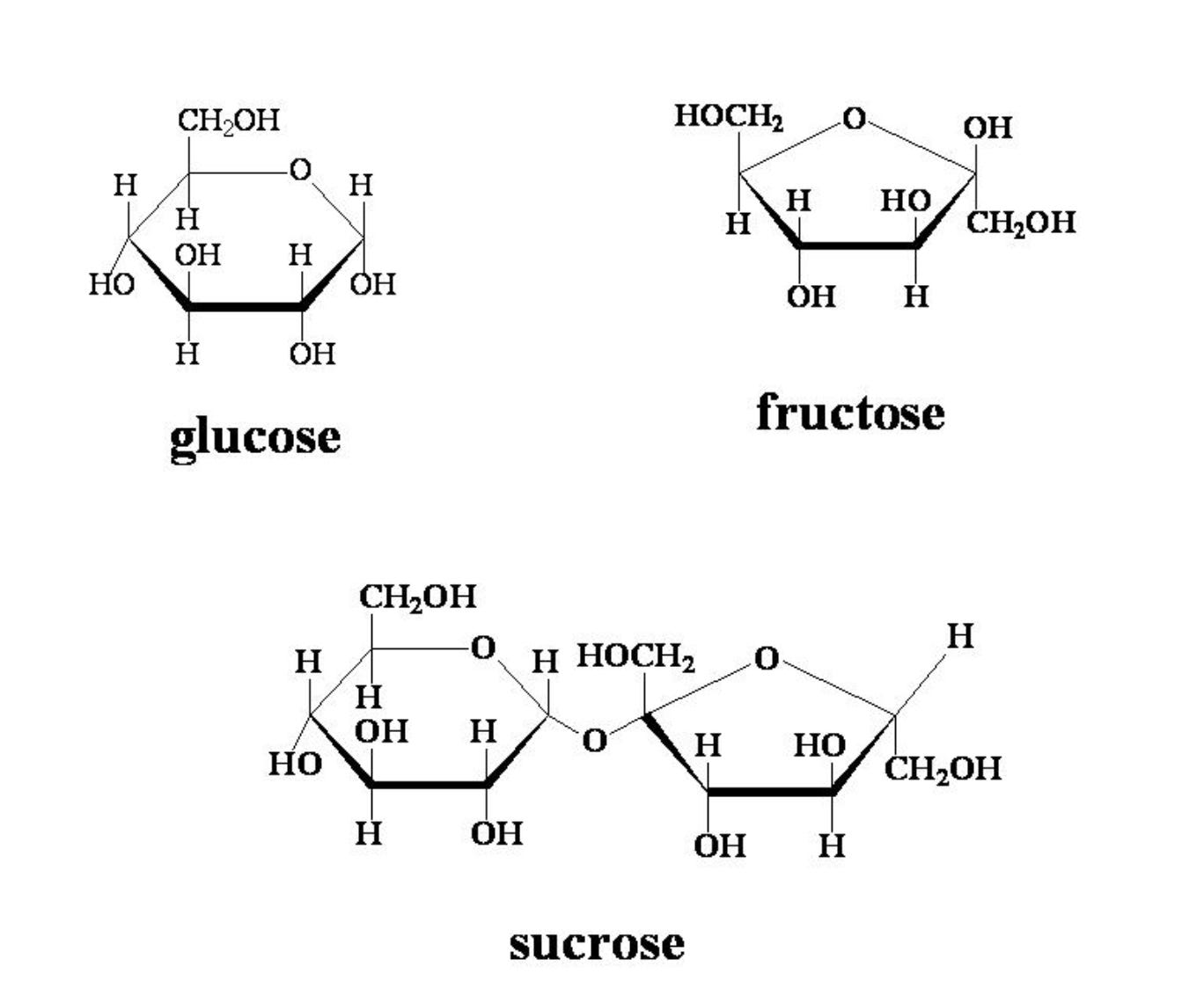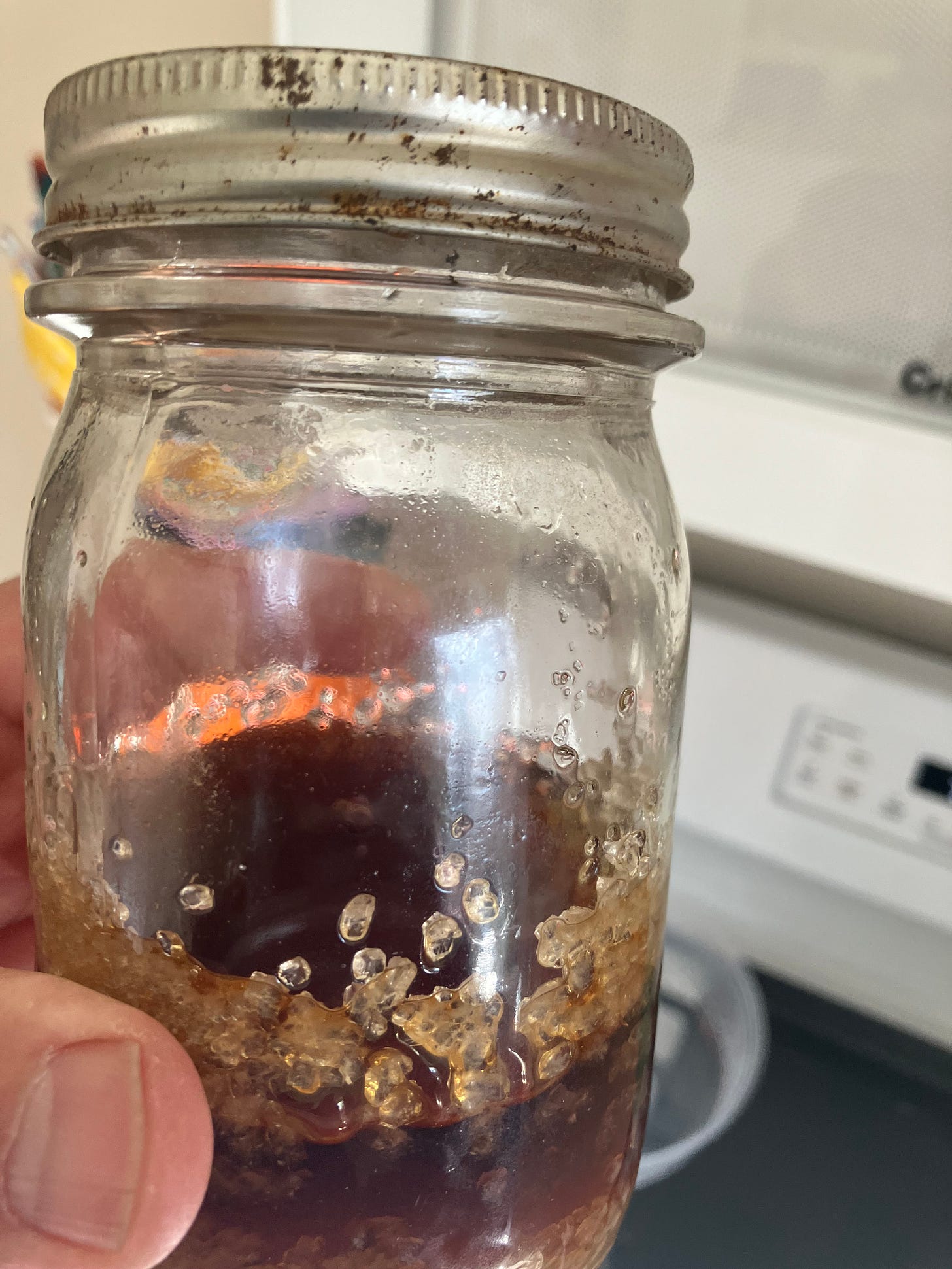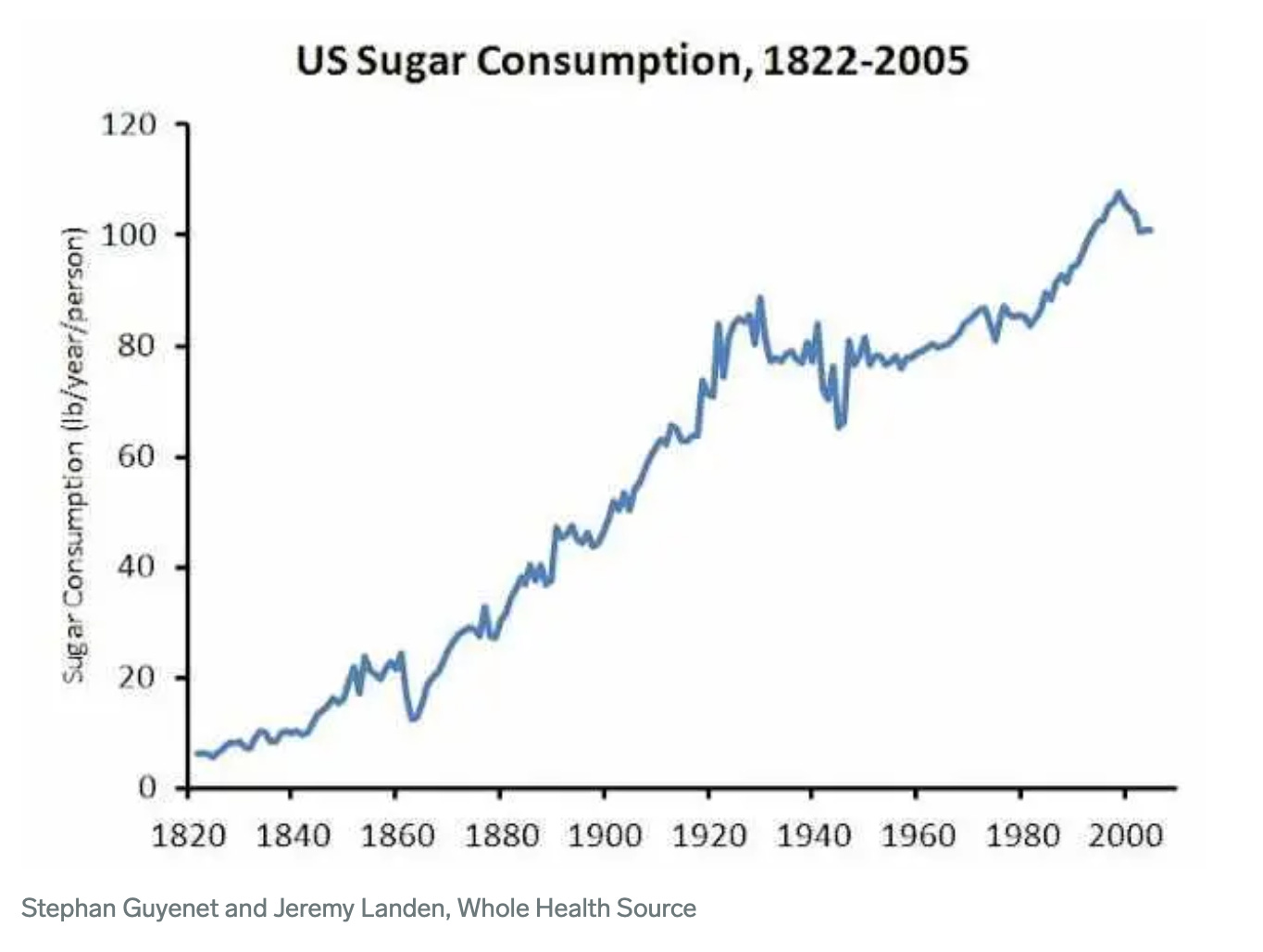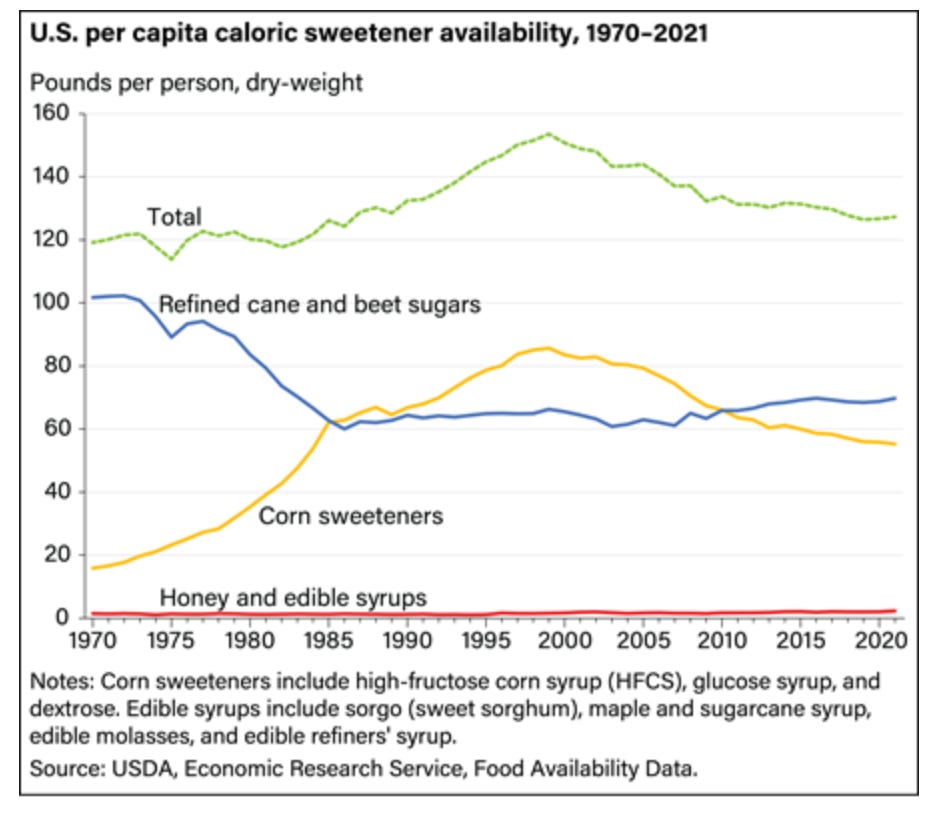Human beings crave sugar and sweets for an inter-related set of biological reasons: 1) a food’s sweet taste signals it contains chemical compounds that provide easily digestible calories, and thus immediate energy; 2) it makes our brain feel good by stimulating production of dopamine; and 3) it helps us store fat in our bodies, which, throughout all except the last 50 of our 300,000-year existence, was a good thing.
‘Sugar’ can mean a few different things in chemistry, but we can think of it as a carbohydrate with the basic molecular formula of Cx(H2O)y. The x and the y imply the number of carbon atoms (C) and water molecules (H2O) contained within a sugar molecule is variable. Carbohydrate literally means hydrated carbon, so there you go.
Sucrose, the carbohydrate in cane sugar and usually the chemical we think of when we think ‘sweet’, is sweet because the molecule attaches to the taste bud in so many places. Imagine if your taste bud is you and a bowl of ice cream is one of those massage chairs at the mall. Mmm hmm. Other sweet chemicals like fructose and glucose produce a similar effect. In fact, sucrose ‘is’ fructose and glucose bonded together, e.g. a ‘polysaccharide’ meaning a polymer of sugars.
Our primate ancestors shared our sweet tooth and this likely can be sourced back 15 million years when fruit-bearing trees became a hot commodity during a prolonged planet-wide cold snap. Taste buds adapted then to prefer ripe fruit with its higher sugar content (1).
The sweet taste of fruit is also a subtle indicator to us that the food may contain Vitamin C. Primates and guinea pigs are the only mammals that lack the capacity to synthesize that compound (ascorbic acid) and thus all need to ingest it. Especially juicy meat contains a lot of sucrose, in case you ever wondered about that craving.
Homo sapiens has done some pretty crazy things to satisfy its sugar craving during its 300,000-year existence on earth. Keeping insects (bees) for livestock, to name one. A seemingly instinctual drive to climb trees may be another (i.e. harvesting fruit). Maybe the craziest is boiling down a swimming pool sized amount of tree sap to get a few pints of syrup. Call me crazy.
What follows should not be considered expert testimony, but rather testimony of the eyewitness kind. Last year, after stumbling upon the maple syrup aisle at Theisen’s and impulsively buying some tree taps, I tapped one silver maple, one boxelder and one walnut tree (yes you can get sweet sap from trees that are not sugar maples). Since I have an enormous pile of firewood, I planned to boil down the sap using a wood fire. I know this can be done but I could not get my fire hot enough and a fair amount of ash ends up landing in your sap pot, which is sub-optimal. And I spilled half my sap by while feeding wood into the fire beneath my jury-rigged-cinder-blocks-supporting-discarded-oven-racks-from-the-Iowa City-Landfill. That is what you call sub-sub-optimal. After switching over to my propane cooker, I ended up getting one pint of syrup.
Last fall I took a walk through my timber and identified several sugar maples using a plant-ID app on my phone and then geo-located them on my old Garmin handheld GPS. I also obtained access to two very large sugar maples in Iowa City. I was set to go once mid-March rolled around, prime time in this neck of the woods.
Then on February 4th I got a text from a friend in Minnesota that slednecks in the Gopher State were tapping trees near Lake City on January 31st! I said ‘no way’ but he said you betcha, hayseed, dontcha know about this climate change thingy and I said I guess I better get my arse out there. Thanks for the heads up dere, Jack. (His name literally is Jack.) So, I got some trees tapped on February 4th and collected sap up until about 10 days ago (more about that ending sap later).
In total I tapped two silver maples, one boxelder, one walnut, and about 8-10 sugar maples. The walnut tree did not produce even a cup of sap, this after yielding a few gallons last year. One silver maple did ok, but the sugar maples did the best by far. After two years, I would have to say boxelders aren’t worth the effort if you have better options. The two big sugar maples in Iowa City and then three sugar maples in my timber at DeSoto, WI produced probably 80% of the sap I collected. I had 12 taps in total and I moved them around from tree to tree depending on what trees were flowing best. I put multiple taps in the bigger trees.
I didn’t mess around with the wood fire this year and boiled everything down with my propane cooker. My advice would be to not start a boil with less than five gallons of sap and some would probably say that’s too small. I boiled the sap down until it was noticeably dark (sap out of the tree is clear) and a maple aroma was coming off with the steam.
At this point I finished up indoors on the stove and the point you stop reducing is pretty critical. Everything I read said stop when it reaches a temperature of 219F. As water is boiled off and the sugar remains, the thermodynamic properties of the solution change. The entropy of excited (heated) sugar molecules disrupt the water molecules’ ability to vaporize. And toward the end, sugar comprises about 70% of the solution’s mass, thus the sugar essentially is dissolving the water and not the other way around, increasing the boiling point beyond the normal for water (212F). In my experience, if you go to 219, you’ve gone too far—sugar will crystallize out of the syrup, or it will turn completely hard in a cool room. Not ruined by any means but the total amount of usable syrup is reduced if you’re crystallizing sugar.
Five gallons of sap yields one pint of syrup (yes you read that correctly). It’s worse with silver maple and boxelder. Making maple syrup is about as climate friendly as using a Hummer to haul a load of coal across Texas for a marshmallow roast. But the taste of that warm syrup coming out of the pan when it’s done—I really can’t put it into words. Here’s my best effort: It’s like the female (I hesitate to use the word ‘Mother’ here) embodiment of nature French-kissing your mouth after you’ve been in prison for 30 years, or some other damned thing, I don’t know. It’s exquisitely delicious, and I do mean exquisitely. And obviously it’s not just the sweetness—there are a lot of other organic compounds present beyond sucrose that impart the maple flavor.
It's a real mind boggler that this country got most of its sugar in this manner prior to the Civil War, when there was an avoidance of cane sugar in the North because it was mostly produced using slave labor. The average American consumed less than 10 pounds of sugar per year in 1820 and that has increased more than 10-fold to the present day. There is some disagreement on exactly how much sugar Americans consume, but it’s somewhere between 95 and 125 grams per person per day now—about ½ cup per day and 76 to 100 pounds per year. Sugar consumption increased steadily from the Civil War until 1920, when amounts leveled off until 1980 when corn sweeteners (fructose and glucose, primarily) became a staple of the American diet.
There has been some on-again, off-again conjecture that the fructose sugar of corn is metabolized by the body differently than the sucrose of sugar cane, beets and maple syrup, and that this has driven obesity in the US. This now seems very unlikely, however, and the emergence of cheap sugar from corn simply inspired us to consume more sugar. American sugar consumption has remained steady or has slightly declined since 1999, mostly because of consumer choices related to soft drinks. We still eat a greater mass of sugar than chicken, beef, pork, fish, potatoes, and more sugar than tomatoes, lettuce, carrots, onions and sweet corn, combined. And the weight of sugar we consume exceeds that of apples, oranges, bananas, grapes, strawberries, watermelon and pineapple—combined.
There’re a few folks out there that badger me about consumer choices driving our water pollution in Iowa. It’s hard to make the case that our sugar addiction drives water pollution when 55% of corn goes to ethanol and another 40% goes to livestock feed. Nonetheless, it’s undeniable that what pollutes our water does indeed pollute our bodies.
If you ever make your own maple syrup, believe me, you will think twice or maybe even ten times before opening that precious jar for your pancake or oatmeal. You’ll want to, very, very badly. Very badly. You’ll want to dip a homemade cookie in it as badly as you want to pluck a tick off an unreachable part of your body on a solo camping trip. And then and only then you’ll know why people in 1820 ate less than 1/10th the amount of sugar that you eat.
Note on late sap: The two Iowa City sugar maples produced sap long after my Wisconsin trees were done. This late sap was turbid and boiled at a much higher temperature from the beginning. I sampled the syrup mid-way through the boil and it did not taste right. The maple syrup flavor was definitely there, but it was as if it had been mixed with vinegar. I tossed it. I later learned this is what is called bud or buddy sap that runs after the tree has budded out.
1) World Economic Forum. The evolutionary reason humans crave sugar. May 8, 2015.
A couple of things. I’ll be on IPR’s River to River with Ben Kieffer tomorrow (Thursday March 14) at noon talking about Iowa Water Quality.
Secondly, I’m a member of the Iowa Writers Collaborative. There are some great writers (shown in the list below) and some big names in that group, and I’m lucky they tolerate a guy like me. They’re all posting here because like me, they want Iowa to be a better place to live, and words are our tools. Several are good friends of mine—Bob Leonard, Steve Semken, Beth Hoffman, Larry Stone and others. I invite you to read them.
Lastly, I’m putting in a plug for an almost-Iowan, NoMo (Northern Missouri) writer Jess Piper. I will be doing an event in Iowa City in May with her where we will be talking about rural decline in Iowa and Missouri and how it links back to consolidation in agriculture. Jess heads the group Blue Missouri. Stay tuned for the exact date.








Sweet! My brother has an operation here in western NY. He has about 2,000 taps on a couple vacuum lines.
And, at Costco there's a huge stock of organic Vermont maple syrup. Hard to believe it's real after reading this. We are so removed from life!
I missed River ti River today. I'll listen to the recorded version.